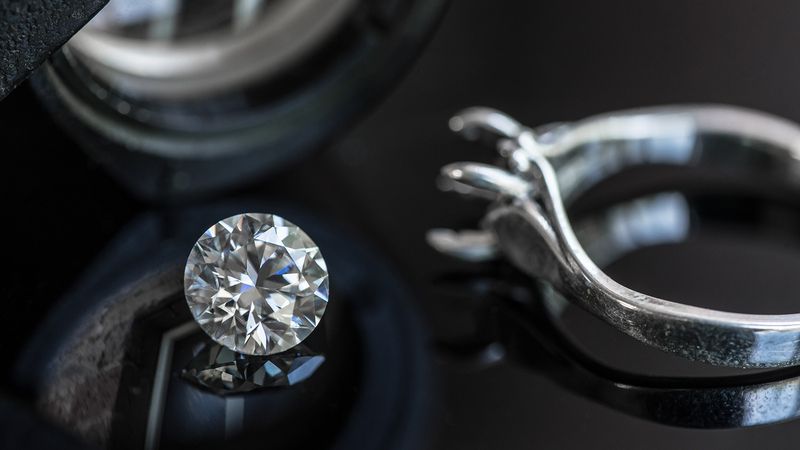This is the first instalment of our series on the 4 Cs (Colour, Clarity, Cut, and Carat Weight) of diamonds.
Today we’ll tackle colour and help you understand how it affects the quality of a diamond. We’ll also be giving you some insider tips on how to get better value when buying diamonds.
The Basics
The term ‘colour’ can be a little misleading, because an ideal diamond actually has no colour at all. The less colour the better!
As colour grade decreases, a diamond typically becomes more yellowish in hue.
The highest colour quality diamonds are best set in white gold and platinum to accentuate the rare lack of colour. Diamonds with colour grades that fall below F can be set into warmer colour metals like yellow gold and will still look great.
There are two main rating scales for grading colour – one from the Gemological Institute of America (GIA), and the other from the American Gem Society (AGS). The GIA scale goes from D (colourless) to Z (light colour). The AGS scale goes from 0 (colourless) to 10 (light colour).
GIA Diamond Colour Scale
Image credit: GIA.edu
Diamond Colour Rating Scale
Colourless (D-F or 0.0-1.0)
These are highest grade of colour quality for diamonds. A diamond with these grades are the best of the best, and will command the highest prices.
Normally, only a gemologist comparing D, E and F diamonds side-by-side would be able to spot any colour difference between these grades. If you don’t spend all day looking at diamonds, it would be very difficult for you to notice a difference between these with the naked eye.
Near Colourless (G-J or 1.5-3.0)
Diamonds at these grades start to have minor tints of colour (typically yellow), which can be difficult to notice with the naked eye. These diamonds are less valuable than D-F graded stones, but are still above average in quality. Within this range, prices tend to increase 10-20% per grade.
Diamonds with G-J grades would still look great in platinum or white gold jewellery, but once you go below J these metals would start to highlight any hints of colour in the diamond.
When you’re considering diamonds and evaluating which aspects of the 4 C’s are most important to you, keep in mind that I-J diamonds can be an affordable option. As they are more common, an I-J diamond may cost half as much as a D diamond.
Faint Colour (K-M or 3.5-4.5)
In this range, colour differences are more easily noticed by the naked eye. You will start to see yellowish, warm tints in these stones.
These lower colour grade diamonds are much less expensive, and setting them in yellow gold can be a very affordable option. For a lot of people however, diamonds in this range have too much colour and are less attractive.
Very Light Colour (N-R or 5.0-7.0)
Diamonds in this range have a very visible yellow (or even brown) hue, and as a result are very inexpensive. Despite the cost-savings, these diamonds are rarely purchased because of the strong colouring.
Light Colour (S-Z or 7.5-10.0+)
In this grade range, diamonds will have a very obvious colour and do not have much value.
Fancy Colour
Past the S-Z range, the yellow colour of these diamonds actually starts to become more attractive and valuable. At a certain point they become yellow ‘Fancy Coloured’ diamonds.
How Does Size Affect Colour?
The size (carat weight) of a diamond will affect the way that people see the colour of a diamond. For example, it is harder to notice colour differences in diamonds that are smaller than a half-carat. For 1 carat or higher diamonds, the differences are more noticeable and it is recommended that you try to stick to colour grades in the D-H range.
The type of metal that the diamond is set in (and the style of setting itself) will also affect how people judge the colour of the diamond. Diamonds with colour grades of H and lower are generally set in jewellery made of yellow gold to offset the yellow tints in the stone. D, E and F grade stones are best showcased in platinum or white gold jewellery.
If you’re looking for a more affordable option, look at diamonds in the I-J colour range and get them set in yellow or rose gold.
How Does Colour Affect Price?
It can be hard to notice the difference in colour between diamonds with the naked eye, but any slight colour variation has a big impact on the quality and price of the stone.
For example, a diamond with a colour grade of F (or 1.0 by the AGS) has less colour than a diamond with a colour grade of L (or 4.0). Diamonds with less colour are less common, which will lead to a higher price.
Simply put – the less colour, the more rare and more valuable.
How Do I Get The Best Value for a Diamond?
If you’re hunting for good value, look at G-J diamonds. To the naked eye (and depending on the metal the diamond is set in), these diamonds will look just like higher colour grade diamonds once they’re set in jewellery.
As we mentioned before, colour is easier to see in larger diamonds, so go for G-H grades for stones 1 carat and up. For those under 1 carat, try I-J diamonds.
Keep in mind the other factors of diamond quality – cut and clarity. Try investing a little less in colour and a little more in cut. A higher cut is more important for the brilliance of a diamond.
Stay tuned for our next post where we’ll look at diamond clarity.

